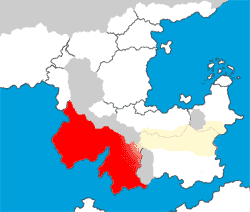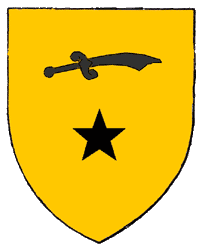Country Info: Kiljukan (the Kiljuk Empire)
 
|
| Terminology: | Kiljuk (KEEL-jook) people, one Kiljuk, many Kiljuks |
| Capital: | Marna (MARR-nah) |
| Monarch: | Sultan Abdülhamid IV. |
| Coat of Arms: | Or, a mullet sable, in chief a scimitar of the second. |
A millennium ago, the current Kiljuk lands were Sturian provinces. After the Empire's fall, the region collapsed into petty kingdoms and fiefs, until the rise of the Kiljuks. Then a tribal, nomadic people, the Kiljuks refined themselves into fierce raiders, migrating en masse into the plains and cities around AI 500.
Today, the Empire holds sway over a vast territory. The Kiljuk ruling class reigns over numerous tribes and peoples, including Bilgoshmen in the Empire's north and Marakhs in the east.
The Kiljuk Empire remains only loosely united by its supreme Sultan. The country's politics remain a consistent struggle between the lords (or "pashas") for the power to rule "behind the throne"; tradition and respect dictate than none should overthrow the heavenly chosen sultan, and the Kiljuks follow this faithfully. However, almost anything else goes.
Kiljuk merchants often cross the desert and mountains which separate Kiljukan from Chardreau in order to trade valuable spices and cloths from Kiljukan and the other southern lands. Of course, Kiljuk mamelukes also make journeys into southern Chardreau, but not for trade!
Religion
Where the tribes in Hesket's north assimilated into Sturian culture, the Kiljuks supplanted it. Unaccustomed to a central religious authority, the Kiljuks did not recognize the authority of the Collegium (a Sturian institution) after completing their conquest. However, as the Empire became more established, the sultans saw the wisdom in having a central religious authority to parallel the central political authority. Nowadays, Kiljuk clergy give allegiance to the Heyet (HAY-ett), a body somewhat like the Collegium.
The Heyet, like the Collegium, allows considerable freedom of worship, and the Bilgoshmen in the conquered territories in the Empire's north still practice Northern rituals and liturgies. However, they are expected to acknowledge the Heyet, not the Collegium, and this often causes friction and resentment. Similarly, the easternmost provinces of the Empire, al-Ebishya, were Marakh emirates prior to their conquest. Marakhin lacks any central religious authority, and many Marakh clergy are not comfortable with Heyet supervision.
Kiljuks are known for the reverence they show Sarana, goddess of music and poetry. The Kiljuk cities are dotted with coffeehouses, where storytellers and musicians delight the crowds. Many of these establishments double as Saranan temples!
Monarch
Sultan Abdülhamid IV. He is moderate and undistinguished compared to past sultans.
Nobles
Ruled by a Sultan (emperor). Under him are various Pashas (dukes or counts, roughly) and Beys (barons).
Major Cities
Marna, the capital, is the largest city in the Empire – but the Empire is large, and contains numerous other sizable cities.
